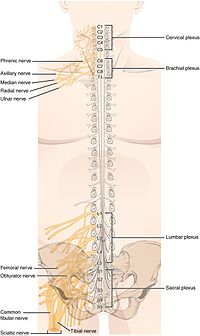Nerve Plexus
- A nerve plexus is a branching network of intersecting nerves.
- The cervical plexus is formed by the ventral rami of the upper four cervical nerves and the upper part of the fifth cervical ventral ramus.
- The brachial plexus is formed by the ventral rami of C5-C8-T1 spinal nerves, and lower and upper halves of C4 and T2 spinal nerves.
- The lumbar plexus is formed by the ventral rami of L1-L5 spinal nerves with a contribution of T12.
Brachial Plexus
- The brachial plexus extends toward the armpit.
- The trunks of the brachial plexus reorganize to form cords around the axillary artery.
- The brachial plexus gives rise to nerves that provide motor and sensory innervation to the shoulder and upper limb.
- The lateral cord is formed by the upper and middle trunk, while all three trunks join to form the posterior cord.
- The lower trunk continues to the medial trunk.
Lumbar Plexus
- The lumbar plexus lies within the psoas major muscle.
- The lumbar plexus serves the skin and muscles of the lower abdominal wall, thigh, and external genitals.
- The femoral nerve is the largest nerve of the lumbar plexus and supplies anterior muscles of the thigh and a part of the skin distal to the inguinal ligament.
- The lumbar plexus is interconnected with the sacral plexus.
- The intercostal nerves do not originate from a plexus and provide motor and sensory innervation to the chest, upper parts of the abdominal wall, pleura, and peritoneum.
Sacral Plexus
- The sacral plexus is located on the posterior wall of the pelvic cavity.
- The sacral plexus innervates the perineal region, buttocks, and lower limb.
- The sciatic nerve, the largest nerve of the human body, is the main branch of the sacral plexus and provides motor innervation to the muscles of the thigh, leg, and foot.
- The common peroneal nerve and its branches innervate some parts of the skin of the foot, peroneal muscles of the leg, and dorsal muscles of the foot.
- The sacral plexus is formed by ventral rami of L4-S3 spinal nerves with parts of L4 and S4.
Autonomic Plexuses
- Autonomic plexuses contain both sympathetic and parasympathetic neurons.
- The cardiac plexus is located near the aortic arch and the carina of the trachea.
- The pulmonary plexus supplies innervation to the bronchial tree.
- The celiac plexus, or solar plexus, is the largest autonomic plexus and provides innervation to multiple abdominal and pelvic organs.
- Other plexuses include the superior and inferior mesenteric plexus, hypogastric plexus, renal plexus, hepatic plexus, splenic plexus, gastric plexus, pancreatic plexus, and testicular/ovarian plexus.
A nerve plexus is a plexus (branching network) of intersecting nerves. A nerve plexus is composed of afferent and efferent fibers that arise from the merging of the anterior rami of spinal nerves and blood vessels. There are five spinal nerve plexuses, except in the thoracic region, as well as other forms of autonomic plexuses, many of which are a part of the enteric nervous system. The nerves that arise from the plexuses have both sensory and motor functions. These functions include muscle contraction, the maintenance of body coordination and control, and the reaction to sensations such as heat, cold, pain, and pressure. There are several plexuses in the body, including:
| Nerve plexus | |
|---|---|
 Superimposed image of the spinal plexuses on a human back. | |
| Identifiers | |
| TA2 | 6172 |
| FMA | 5901 |
| Anatomical terms of neuroanatomy | |